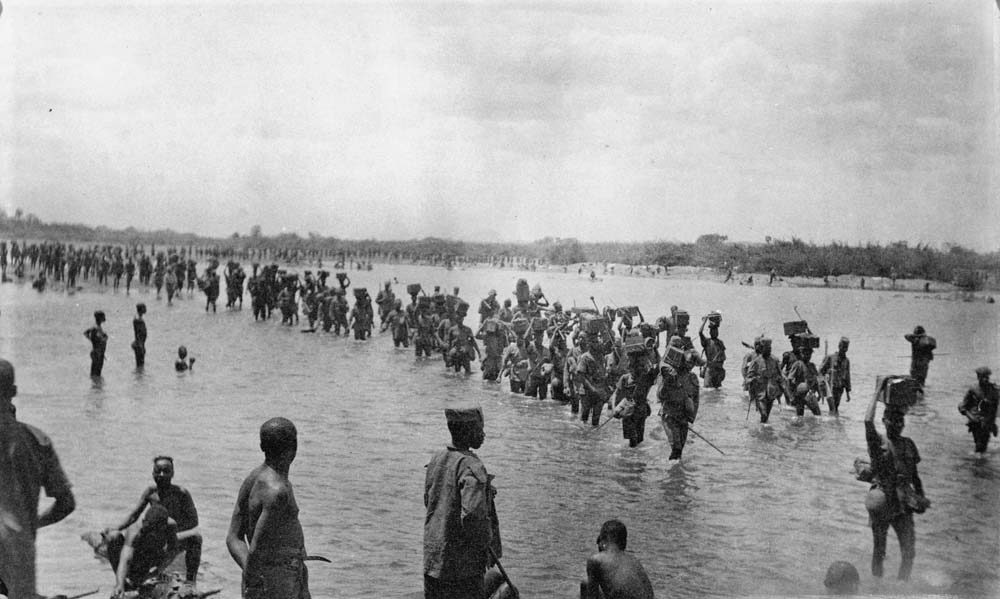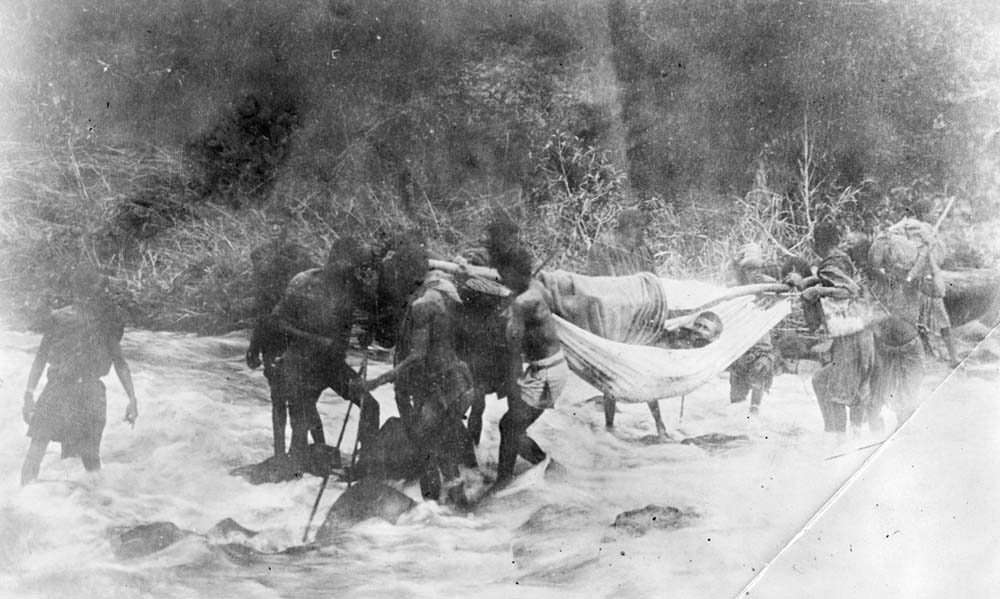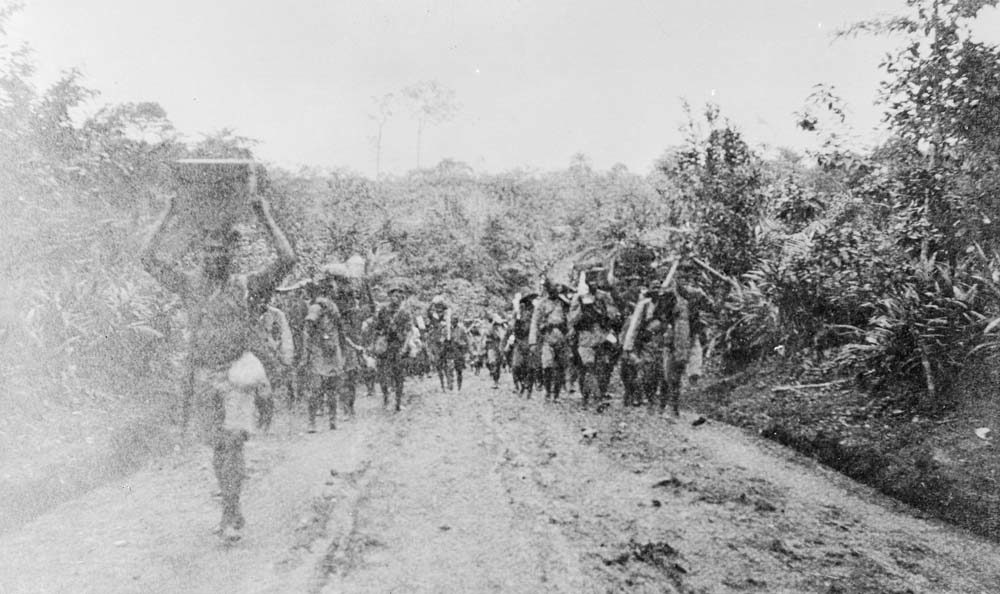13 October 2022
The Carriers’ Tale: Remembering South African Labour Corps
Black South African logistics troops played a key role in several Great War Campaigns. This is the story of the Labour Corps.
South African Carrier & Logistics Troops

South African labour troops wade through water while carrying important cargo.
Who were the South African labour units?
During World War One, thousands of Black South Africans were enlisted for non-combatant duties. These men provided a very important role in their respective theatres, helping acquire and deliver to the front the means to fight a war, including essentials such as ammunition and food.
Some men, like the South African Native Labour Contingent, saw service providing vital logistical services on European battlefields. Around 21,000 served in France and Belgium. At the Commission, we look after nearly 1,000 men who died during their service between November 1916-1918.
However, the men of the South African Native Labour Contingent have had their story told in more detail than their compatriots who served in Africa itself.
People often forget that the battlefields of the Great War were not restricted to Northern France or Southern Belgium. This was a truly global war fought by globe-spanning empires. Africa itself was no stranger to conflict during the Great War.

Labour units cross a river
In the early part of the war, some 35,000 Black South Africans provided labour during the invasion of German South-West Africa (present-day Namibia). Another 18,000 would be recruited to provide labour in later campaigns in German East Africa (present-day Tanzania).
The units that served in the various African theatres included:
- Cape Coloured Labour Regiment
- Cape Auxiliary Horse Transport
- Military Labour Bureau
- Military Labour Corps
While this article focuses on the South African labour experience, it’s important to widen the picture somewhat. The war in Africa was not a European one.
The British Empire and its African possessions were able to field some 150,000 men to fight in East Africa alone. That number is dwarfed by the number of African support troops involved – some one million men.
What was the role of South African labour units?

The geography and terrain of some African theatres meant ferrying supplies by hand was the only workable option.
As their name suggests, these units were drafted to provide auxiliary labour services in support of frontline troops.
US General Robert H. Barrow’s adage that “amateurs study tactics, professionals study logistics” runs true for warfare throughout the centuries but is particularly pertinent to the war in East Africa. The men at the front require regular supplies of ammunition, food, and water to keep going. This is where the often-ignored labour units played their part.
Among other locally raised forces, these South African troops fulfilled a wide range of auxiliary roles during their time in the military. They acted as stevedores, wagon drivers, railway builders, transporters, repairers and in other differing support functions.
In some African theatres, the local infrastructure and conditions meant men were the best source of transport.
For instance, in German East Africa, rail and road networks were scarce. The prevalence of the tsetse fly also prevented the use of pack animals. As a result, it was up to the men of the labour units to ferry their cargo to their frontline comrades, which was no easy task.
By way of illustration, to provide food for a day for 1,000 askari (local troops) serving with General Northey in what was Northern Rhodesia, 16,500 carriers were needed. As supply lines were so long, 14,000 of these men carried food for the column and the remaining 2,500 carried food for the troops.
But these labour units did not only carry equipment, foodstuffs, supplies, and material. They acted as ox drivers where necessary and provided road building and scrub clearing services necessary for keeping supply lines open in difficult conditions.
As any student of military history will tell you, illness was a huge killer amongst soldiers and labour corps troops throughout the ages. Unfortunately, ailments like malaria struck down thousands of South African troops during their service. Men not taken by tropical illnesses often returned home very ill.
Despite their backbreaking tasks and terrible experiences dealing with disease and ailments, the men of the South African labour corps made a huge contribution to the war effort. The impact of strong supply lines on the ability of men at the front to be able to fight cannot be underestimated.
Unfortunately, the names of the majority of those who died while service with South African labour units on the continent of Africa were never provided to the Commission, which resulted in them not being commemorated in an appropriate manner. We are aiming to change that.
The remit of the Commission’s Non-Commemorations Project is to address and rebalance these errors, ensuring men and women from around the world are given the commemoration they deserve.
We spoke earlier about how the number of African support troops greatly outweighed frontline troops in the numerous African campaigns. Because they served in greater numbers, they died in greater numbers too.
The mobile nature of warfare in Africa meant there was little respite for reserve and logistics troops.
For example, the official death toll of British Imperial troops in the East African campaign comes to just over 11,000. For all African carriers in the theatre, the number is unlikely to be less than 100,000.
The stories of the men of South African labour units deserve to be told; stories of men like Dolly Jenniker and Zulu Madhliwa.
Dolly and Zulu were enlisted as Boat Men and employed by the South African Railways and Harbours Department at The Point in Durban. While working on loan to the South African Defence Department, they were drowned on the 23rd of January 1915 when the craft they were piloting capsized while transporting supplies across the Orange River while it was in flood.
Dolly never got to return to his wife, Molly Jenniker, in South End, Port Elizabeth. Zulu’s father, Ngobongwana, never saw him again. His son never came home to Amanzimtoti, only £3 of his unpaid wages.

